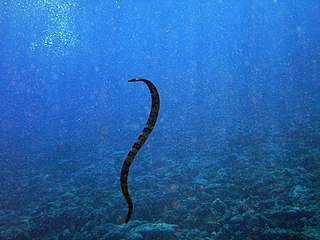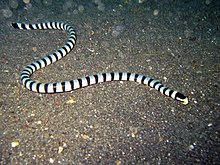
Elapidae is a family of snakes characterized by their permanently erect fangs at the front of the mouth. Most elapids are venomous, with the exception of the genus Emydocephalus. Many members of this family exhibit a threat display of rearing upwards while spreading out a neck flap. Elapids are endemic to tropical and subtropical regions around the world, with terrestrial forms in Asia, Australia, Africa, and the Americas and marine forms in the Pacific and Indian Oceans. Members of the family have a wide range of sizes, from the 18 cm (7.1 in) white-lipped snake to the 5.85 m king cobra. Most species have neurotoxic venom that is channeled by their hollow fangs, and some may contain other toxic components in various proportions. The family includes 55 genera with around 360 species and over 170 subspecies.

Acrochordus granulatus is a snake species found from India through Southeast Asia to the Solomon Islands. It is known as the little file snake, marine file snake, and little wart snake. It is completely aquatic and almost helpless on land. No subspecies are currently recognized.

Hydrophis curtus, also known as Shaw's Sea Snake, short sea snake, but often includes Hydrophis hardwickii is a species of sea snake. Like most Hydrophiinae sea snakes, it is a viviparous, fully marine, and front fanged elapid that is highly venomous. It is collected for a variety of purposes including human and animal food, for medicinal purposes and for their skin.

The yellow-lipped sea krait, also known as the banded sea krait or colubrine sea krait, is a species of venomous sea snake found in tropical Indo-Pacific oceanic waters. The snake has distinctive black stripes and a yellow snout, with a paddle-like tail for use in swimming.

The blue-lipped sea krait, also known as the blue-banded sea krait or common sea krait, is a species of venomous sea snake in the subfamily Laticaudinae of the family Elapidae. It is found in the Indian and Western Pacific Oceans.

Sea snakes, or coral reef snakes, are elapid snakes that inhabit marine environments for most or all of their lives. They belong to two subfamilies, Hydrophiinae and Laticaudinae. Hydrophiinae also includes Australasian terrestrial snakes, whereas Laticaudinae only includes the sea kraits (Laticauda), of which three species are found exclusively in freshwater. If these three freshwater species are excluded, there are 69 species of sea snakes divided among seven genera.

The katuali or flat-tail sea snake is a species of venomous sea snake in the family Elapidae. The species is found only in the waters of the Pacific Islands nation of Niue.

The black-banded sea krait, also known commonly as the Chinese sea snake, is a largely amphibious species of venomous marine reptile in the subfamily Laticaudinae, family Elapidae. It is found in much of the western Pacific Ocean and some of the Sea of Japan. In Japan, it is known as erabu umi hebi ; in Okinawa, it is known simply as irabu.

Crocker's sea snake is a species of venomous snake in the subfamily Laticaudinae of the family Elapidae. The species is native to Oceania.

The extant (living) reptiles of New Zealand consist of numerous species of terrestrial lizards and the lizard-like tuatara, and several species of sea turtles and sea snakes. All but one species are native to New Zealand, and all but one of the terrestrial species are endemic to New Zealand, that is, they are not found in any other country. Many species of foreign reptiles enter New Zealand through accidental importation or smuggling, but only the Australian native Lampropholis delicata has become established in the wild, and it is considered an invasive pest.

The yellow-bellied sea snake is a venomous species of snake from the subfamily Hydrophiinae found in tropical oceanic waters around the world except for the Atlantic Ocean. For many years, it was placed in the monotypic genus Pelamis, but recent molecular evidence indicates it lies within the genus Hydrophis.

The Lamprophiidae are a family of snakes found throughout much of Africa, including the Seychelles. There are 89 species as of July 2022.

The New Caledonian sea krait is a species of venomous snake in the subfamily Laticaudinae of the family Elapidae. The species is native to the waters around New Caledonia.

Vladimir Yemelyanovich Kharin (1957–2013) was a Russian zoologist, ichthyologist, herpetologist, and a specialist in sea snakes.

The slender-necked sea snake, also known commonly as Cogger's sea snake, is a species of marine venomous snake in the subfamily Hydrophiinae of the family Elapidae. The species is native to waters around western Australia and the southern Pacific Ocean.

The Elapoidea are a superfamily of snakes in the clade Colubroides, traditionally comprising the families Lamprophiidae and Elapidae. Advanced genomic sequence studies, however, have found lamprophiids to be paraphyletic in respect to elapids, and anywhere between four and nine families are now recognized.
Laticauda guineai is a species of venomous sea snake in the family Elapidae. The species, which was first described by Heatwole, Busack and Cogger in 2005, is native to waters off southern New Guinea.














